Let’s Learn About: NEAT, TEPA, BMR, TEF, TDEE, And How We Can Use Them To Enrich Our Lives
As with most of my blog posts, someone asks a question and I answer it with my current knowledge base, and then I think, “hmm, let’s delve into this futher.” And as always, I end up learning more, researching more, questioning more, and then ultimately writing a few pages when all I wanted was a few paragraphs. Welcome to the latest version of exactly that.
TDEE
(BMR) Basal Metabolic Rate (60%-75%) + (TEF) Thermic Effect From Food (10%) + (TEPA) Thermic Effect of Physical Activity & (NEAT) Non Exercise Activity Thermogenesis (15%-30%) = (TDEE) Total Daily Energy Expenditure (100%)
Wait! Come back, relax. I know some of you had flashbacks to high school algebra. I know I would. I see that and my brain says, “nah.” But wait, these are pretty interesting and we’re going to go through these and make it fun!
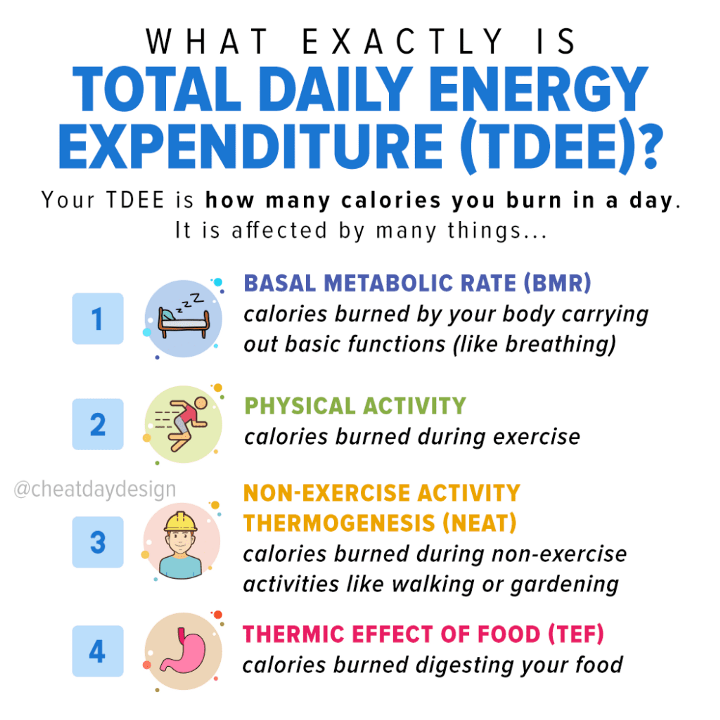
So the TDEE is an estimation of how many calories you need on a daily basis including exercise. Why is this important? Well hypothetically if you know this number, it can give you a better chance of knowing how many calories you need on a daily basis and you can make better decisions regarding food consumption. If you’re into counting calories. I’m not. The main purpose of my little blog is to make you aware of these terms, why they’re important to your health and fitness, and in turn help you make better life choices. That’s all.
NEAT
What does it mean? NEAT stands for Non Exercise Activity Thermogenesis. This may not be ringing a bell. So, Thermogenesis is the process of heat production in organisms. It occurs in all warm-blooded animals, and also in a few species of thermogenic plants. As far as fitness or health is concerned, when your body burns calories, it generates more heat, so foods or activities that boost metabolism or fat burning are considered thermogenic.
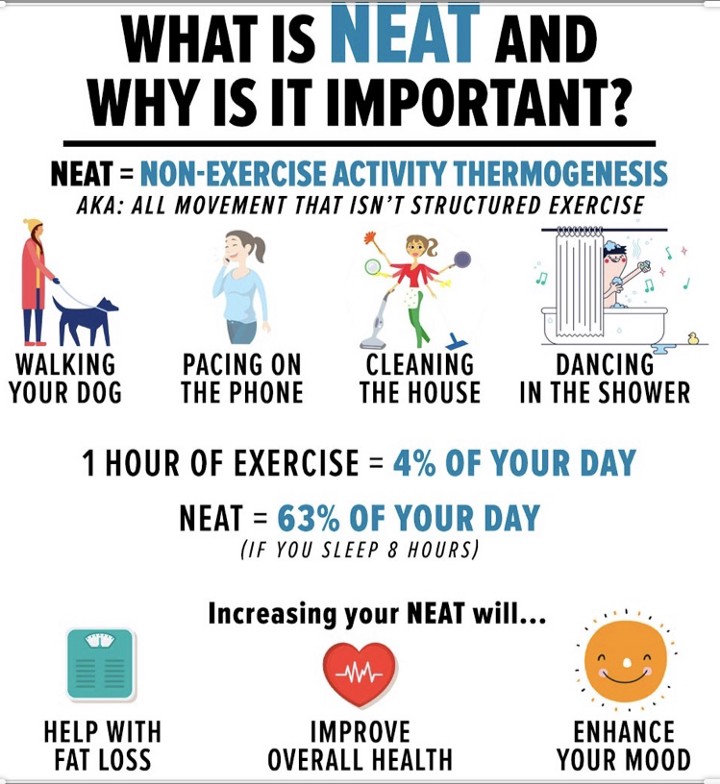
Why is NEAT so important? Why are we leading off with NEAT and not TEPA? Wellm there’s 24 hours in a day. Eight of them I hope you’re sleeping. One of them I hope you’re working out with me or someone just as charming, or just by yourself. We’re only at nine hours. We have thirteen more to deal with! So how you spend those other 13 hours (or as you see on the slide to your left, 63% of your day) could make a huge difference in your overall health.
A simple walk around the block or down to the beach, doing squats while you’re at your desk. Taking the stairs instead of the elevator. Who wants an elevator anyway these days? It’s important to fit in other activities besides just working out into your day. And if you’re not working out, it’s even more important!
TEPA
Thermic Effect of Physical Activity. This is obviously near and dear to my heart. This alone could be a blog post, but let’s keep it simple. Or maybe not. Okay, we’re going deep. As you see below, the different activities and estimated amount of calories burned during an hour of doing said activity. Take a look at resistance training and running. Resistance training burns 455 calories for a 200 lb person. Running burns 755 calories for a 200 lb. person.
So initial thinking, you’d assume that running is going to burn more calories for you. Let’s take a deeper look.
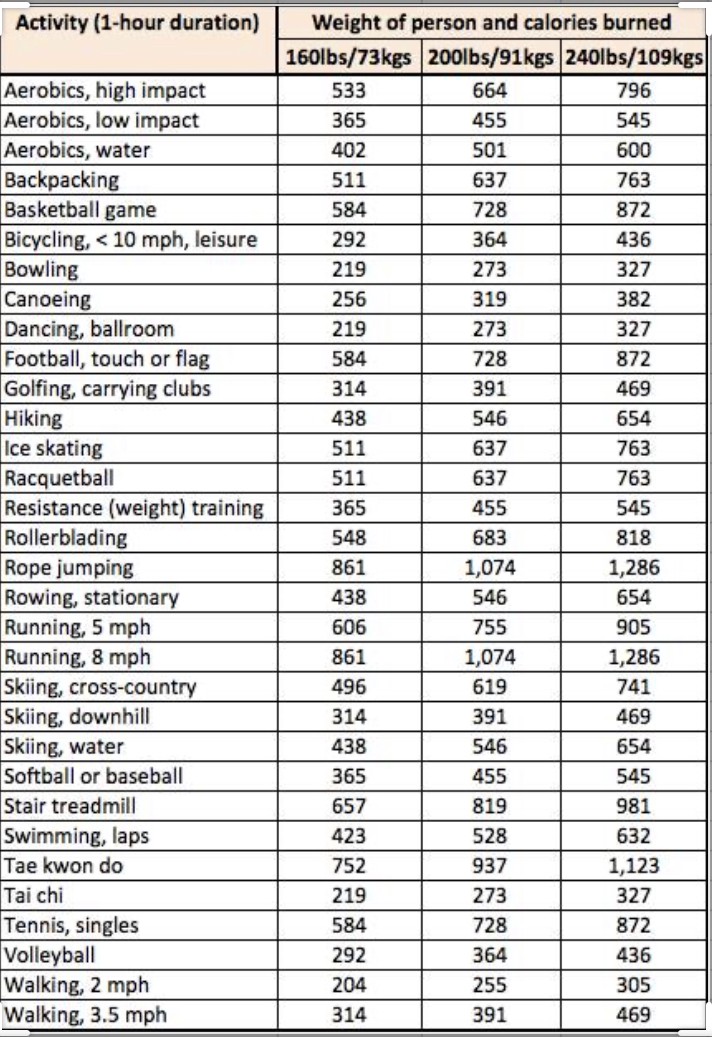
There are two more acronyms we’re going to introduce, HIIT (High Intensity Interval Training) and LISS (Low Intensity Steady State). Why are they important to TEPA and even the next thing we’ll mention which is BMR or your resting metabolic rate?
(I’m going to lump HIIT workouts and Strength training workouts into the same category for this for the simple reason of the after effects of both)
Here’s why. HIIT workouts are short (typically 30 minutes to 1 hour) and at many points of the workout you should be exerting max effort. You may reach heart rate levels 80 to 95 percent of your max heart rate when you’re pushing it and 40 to 55 percent when you’re not. A LISS workout is typically at least 45 minutes. At the very least for me anyway. And while it may be long, you’re never coming close to max effort. It’s more about staying steady.
So think of the carnage to your body after a workout that requires repeated maximal exertions. And then think of the body after a low intensity steady workout. The work your body has to do to get you back to homeostasis is significanlty different. It’s like cleaning up after a hurricane vs. a rain shower. The sheer amount of damage you’re doing to your body during a HIIT workout vs. a LIIT workout is considerable. A typical HIIT workout could mean your body is working half of the day! Compared to your body just working during the LISS workout. Here is a good read: Aerobic Exercise: No Post-Exercise Thermogenic Effects.
Basically what that article says is that LISS causes no increases in metabolic rate after the exercise is over. And thus only causes energy utilization while the exercise is being performed. In fact the article stated that the increase in metabolic rate is no different than eating a mixed meal on a non-exercise day. Ouch! In contrast, the after effects of a strength workout had after effects or an increased matabolic rate for up to 12 hours! Because resting energy expenditure accounts for 60% to 75% of the calories you burn each day, any increase in resting energy expenditure is extremely important to your weight-loss effort.
I said we’re going deep. Here we go. There’s more to just the after effects of a hard workout and rise in metabolic rate. Your body uses fat as more of a fuel source when you’re at rest. So all the more reason to have it be working a little harder.
Here is an excerpt from an article written by Len Kravitz, a very respected Ph.D in the exercise world. Not the singer. He’s referring to a study he did with subjects that were exposed to hearty strength training workouts. Read it and then I’ll break some of it down after.
- *The control day is a non-exercise day.
- *Lipolysis is the metabolism of fat.
Energy expenditure was elevated approximately 10.5% higher for 40 minutes after the workout day as compared to the control day. This effect confirms research shown in other studies (Bennard, Imbeautl and Doucet, 2005).
Secondly, and perhaps more meaningfully, microdialysis data indicated that glycerol levels (the marker for lipolysis) were raised 78% during and 75% after the resistance training as compared with corresponding times on the control day. In addition, the indirect calorimetry data showed that fat oxidation was 105% higher after the workout day as compared to the control session. Thus fat is definitely being used above resting values as a fuel (in conjunction with carbohydraes) during and after the resistance training bout. The enhanced lipolysis during and after exercise is hypothesized to be due to the increased levels of epinephrine and norepinephrine (Ormsbee et al., 2007; Bennard, Imbeautl and Doucet, 2005). In addition, previous research (Bennard, Imbeautl and Doucet, 2005) shows that growth hormone (a powerful activator of lipolysis) has been shown to be elevated after exercise and thus also contributes greatly to this post-exercise fat oxidation.
I think three really interesting things here are: One, who knew that fat oxidation increased that much! 105%! Also, the rise in epinephrine and norepinephrine. This is due to the rise in the sympathetic nervous system or the fight of flight part of our nervous system. I didn’t take into account the nervous system response to these types of workouts which are more like our ancestors fighting tigers, hence the sympathetic response. Rest assured that is not increasing during an aerobic workout. Finally, the rise in growth hormone and its effects in connection to post exercise fat oxidation. Pretty cool. (Shrug).
So overall, yes TEPA certainly enhances your metabolic rate. But, as we’ve just seen the intensity, ie strength training, can really enhance the level of fat burning especially after the workout.
BMR — Your Basal Metabolic Rate. This is the energy requirement when you’re motionless. This makes up about 60% of your energy requirement. Sleep, chilling at a desk, basically when we’re not active. As you can see below the normal bodily functions use quite a bit of energy. How can we increase our BMR? Build muscle. One of the most effective ways to raise your BMR is to increase your muscle mass. Muscle tissue is the most metabolically active tissue in your body, and the breakdown of old protein and synthesis of new protein in your muscles accounts for roughly one-fifth of your resting metabolic rate, writes Len Kravitz, Ph.D. for the University of New Mexico. That’s significantly more than the metabolic rate of fat, which contributes an average of only 5 percent to your daily resting metabolism.
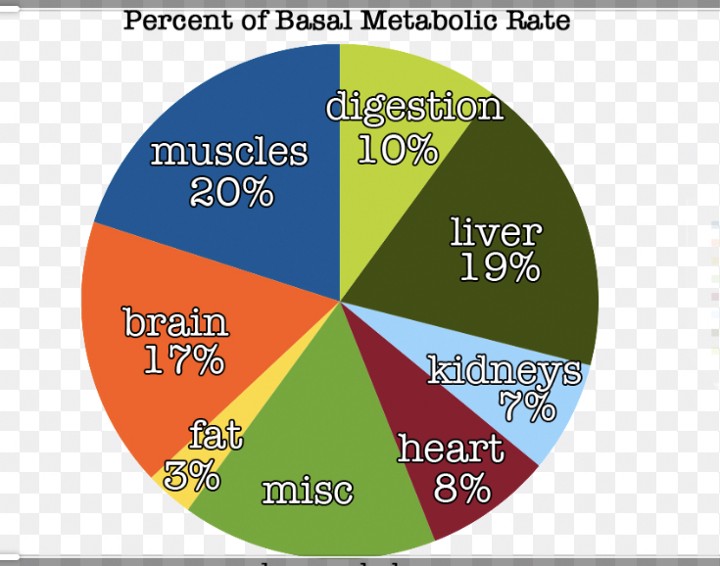
How else can we increase our BMR? A good workout? When does the work happen? After the workout. As mentioned above, the metabolic rate can be increased for up to fifteen hours! I tell my clients this: Your body is lazy. It wants to preserve as much energy as possible. Remember, we’re wired like our ancestors who may have not known where and when the next meal was going to be. So after an intense workout your body says, “That sucked.” We better be more prepared the next time that happens. Let’s build muscle, make our cardiovascular system more efficient, let’s get back to normal!
What does your body need after an intense workout? Let’s introduce yet another acronym. EPOC (Excess Post-Exercise Oxygen Consumption) After an intense workout, what has to happen?
- Resynthesis of muscle glycogen from lactate
- Restore oxygen levels in venous blood, skeletal muscle blood and myoglobin
- Work with protein for the repair of muscle tissue damaged during the workout
- Restore body temperature to resting levels
- Oxygen to help with ATP production (your body’s energy currency)
- Need to eliminate metabolic wastes (carbon dioxide, lactic acid) that the chemical reactions generate.
- Need to get rid of heat. Just like an electric motor, a working muscle generates heat that it needs to get rid of.
Overall any fitness training that you do is going to increase your BMR, but strength training and incorporating high intensity training into your training is just going to increase it a little bit more.
TEF
The thermic effect of food is the energy required for digestion, absorption, and disposal of ingested nutrients. Its magnitude depends on the composition of the food consumed.
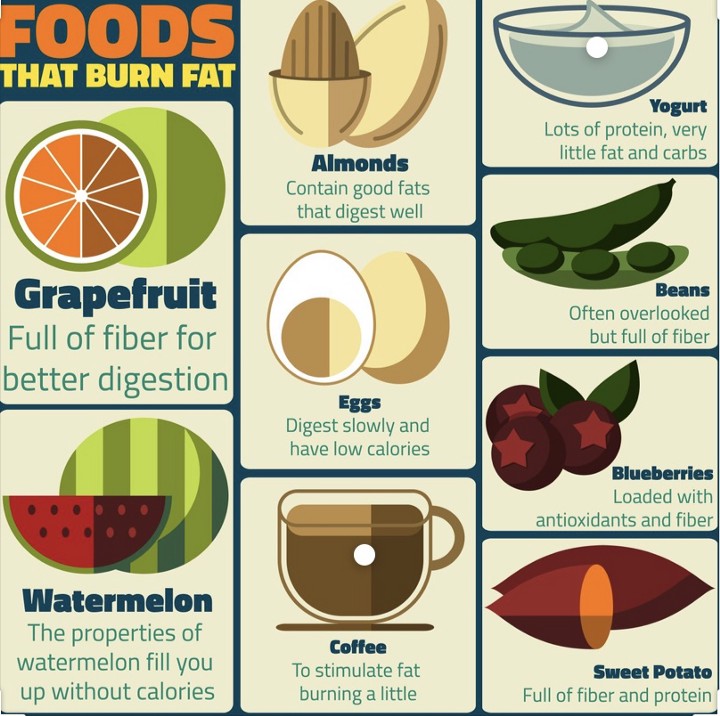
Research shows that protein-rich foods increase TEF the most. For example, they increase your metabolic rate by 20–30%, compared to 5–10% for carbs and 5–10% for fats. If were chewing and working to digest our food, it’s certainly burning more calories than drinking a smoothie.
In the book, “Breathe” by James Nestor, he stated that our ancestors used to chew four hours a day. Today I think we’re lucky if we chew one hour. So overall this adds a small component to energy consumption. More importantly, all or most of the foods that are deemed having a higher TEF, also seem to be essential in maintaining a healthy and nutritious diet. So may be better to eat more of those.
Listen, I just want you to have a better understanding of these terms and how they can effect your health and fitness goals. Now you know why strength training is important. Not only because being weak sucks, but because muscle and the training involved are not only giving you confidence, but also the training is benefitting you for hours after the workout. Now you know that the foods you should be eating are not only healthy for being productive and energizing, but also keeping you slim by making your digestive system working longer. And I really hope you realize that you can be more active when you’re not exercising and how much of an effect that can have on your overall health. So have fun and stay active!!

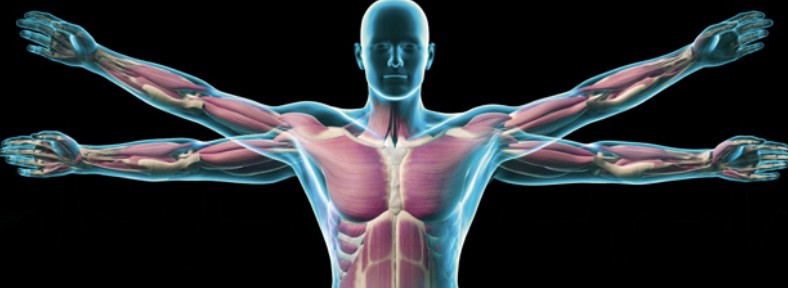


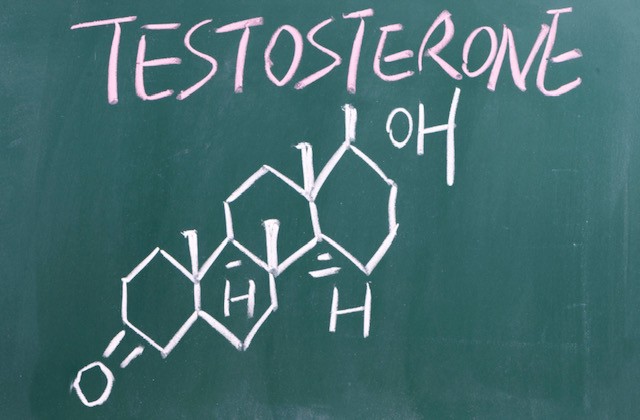

Responses